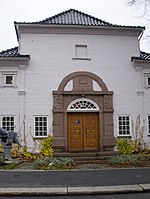The international schools at Skagerak are a group of private schools located on the waterfront in Sandefjord, Norway. Skagerak is located at the prestigious premises of the former shipyard administration at Framnes. They comprise a kindergarten, primary school, middle school, and a high school. The high school is recognized as an International Baccalaureate World School. Together, they promote mutual respect, intercultural awareness and international-mindedness through the International Baccalaureate programmes: the Diploma, Middle Years and Primary Years programmes. The PYP was authorized in June 2006 and the Middle School is a candidate for MYP authorization in June 2007.The Skagerak schools were founded to provide a high level of education and quality teaching concerning each student. The schools’ population is made up of a mix of Norwegian students, those who have lived overseas, and students with a variety of other nationalities. Although English is the language of instruction, students are, or become, bilingual and several additional languages are offered in the middle and high schools. The teachers are as diverse as the students, providing a wide range of international influence and knowledge. Although relatively small, Skagerak offers students a varied curriculum with opportunities such as outdoor education, cultural trips, service, performing arts, and sport.
Annual ski trips take place from PY6 and up, and Primary, and Middle School students participate in organized outdoor education programs of excursions and camps, along with two or more annual international trips. High School students often participate in service-oriented trips to Central Asia, Africa, and Europe. As of 2009, the school had 359 enrolled students from 20 countries. It was 34 full-time faculty members and 6 part-time, originating from 13 countries. The faculty is highly experienced, and most have backgrounds in international education. Students benefit from English medium education with an additional emphasis on other languages to support bilingualism. The school is operated by its own independent Board of Governors.Representatives for the world's leading universities are visiting the high school yearly, and Skagerak offers university guidance for graduates. High School classes also attend international universities which have previously included University of British Columbia in Canada, Glyndŵr University in Wales, London School of Economics, and others. Despite being a private school, it is recognized by the Norwegian State Educational Loan Fund, which funds 85 percent of the tuition fees. Sports offered at Skagerak are soccer, tennis, volleyball, basketball, gymnastics, athletics, and indoor games. The campus facilities encompass two playing fields, two basketball courts, a tennis court, and a turf playing area. It has a cafeteria, an art room, and three science laboratories.The annual graduation for High School students takes place during a ceremony held at the Banquet Hall at Scandic Park Hotel. Diplomas and awards are awarded at the ceremony.As of 2011, there were 173 students enrolled at its high school, 102 at its middle school, and 95 at its elementary school. For high school students, 85 percent of the cost is covered by the state, and students paid an annual fee out-of-pocket of 20,790 NOK.











